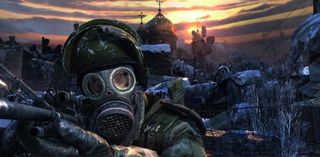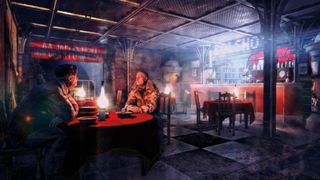Metro: Last Light preview - we venture deep into 4A Games' gloomy Muscovite shooter

This preview originally appeared in issue 248 of PC Gamer UK shortly before THQ's implosion. 4A Games has since been acquired by Koch Media, and though the game's release is still anticipated, no definitive release date has been announced since.
In the tunnels beneath post-nuclear Moscow, there is a town called Theater. Like much of what passes for civilisation in Russian sci-fi author Dmitry Glukhovsky's apocalypse, it's built into the old subway – the metro system for which 4A Games' shooter series is named.
Theater's curving tilework makes it look like it might have had a bit of class, back in the day. The walls could be marble, and although they're streaked with grime they're dazzlingly white by the standards of this rust-and-blood dystopia.
I'm watching one of Metro: Last Light's non-combat sections. The campaign will lead protagonist Artyom through four waystations of this kind, places where the player can trade top-grade ammo for weapons and upgrades, scout out additional plot information, and otherwise absorb 4A's meticulous rendering of the world in the year 2034.
Artyom passes through Theater's kitchens, where a panhandling drama critic bemoans the irrelevance of his profession. Not without reason: this is a world where life is measured in bullets and gasmask filters rather than glasses of Prosecco and those little tubs of ice cream with a wooden spoon in the lid.

High art might have been a casualty of nuclear war, but culture survives. Outside the market, there's an area where an older man performs shadow puppets for an assembled crowd of children. He makes a bird and an elephant, and his audience interprets these as a demon and a nosalis – two of the mutated creatures that prowl Moscow's unsettled tunnels and blasted surface. The sequence is a touching little meditation on what it's like to be born after the end of the world. It also illustrates what 4A's proprietary engine is capable of. Dynamic lighting, audio and physics support everything that 4A are trying to achieve, from wandering around a town packed with refugees to stalking human enemies through the shadows, or engaging in a running battle with a pack of monsters.
A short time later Artyom reaches the theatre itself, where he is joined by Pavel – a returning character from the first game. As they make their way through the crowded auditorium during a burlesque performance, Pavel turns to the player and quips: “well, Stanislavski, you can watch the show if you like.”
Comic deals, prizes and latest news
Sign up to get the best content of the week, and great gaming deals, as picked by the editors.
A 20th century Russian dramatist is an odd point of reference for a character who makes his living blasting mutated rats the size of ponies, but it's a neat touchstone for Metro: Last Light itself. 4A Games are based in Ukraine. They're part of the Eastern European development ecosystem, and share a measure of its enthusiasm for simulation. Metro isn't concerned with realism in the same way as Arma – once again, rats the size of ponies – but it boasts a naturalistic attention to detail and a vigilant support for the fourth wall. If Call of Duty is a broadway musical, a wide-barrelled cannon loaded with glitter and aimed squarely at the audience's face, then Metro: Last Light is trying to be something smarter, tougher, and more rewarding – Stanislavski's Moscow Art Theatre, perhaps.

“It's this obsessive attention to every minute detail, on each individual thing in the world – the culmination is something that is greater than the sum of its parts,” THQ creative strategist Huw Beynon tells me. “We really want to impress on people playing the game that this isn't a level. It's an environment. A place.”
It's something most apparent when Artyom is facing human opponents. During one mission to escape from an engineering yard patrolled by Reich fascists, idle guards can be seen working out, tending fires, sleeping, singing and talking shop.
Metro: Last Light's stealth system is deep rather than broad, and grounded in realism. Like its predecessor, the game has a very minimal UI, with no crosshair and no artificial assists such as a mini-map or sight cones for patrolling enemies. Instead, you'll rely on the equipment in Artyom's possession: a torch, a lighter, a photosensitive gadget on his watch that glows when he's standing in light to let you know he's in danger of being spotted. Noise is important, too: even the game's hand-pumped pneumatic guns aren't perfectly silent, and will get you detected if you use them in close proximity to an enemy. The more power you pump into them, the louder they hiss – and this isn't just a signal to the player that they can stop cranking the handle. It's a sound, in the world, that a curious guard may respond to.

Throwing knives offer a guaranteed silent kill, as do lethal and non-lethal melee takedowns: but all of these require that you catch your opponent off-guard, and that means traversing the level carefully. Most light sources can be shot out, and electric lamps can be brought down at junction boxes scattered throughout each stage. Doing so will raise suspicion, however. Not only that, but the kind of light matters. Shoot out a lightbulb and you'll plunge an area into darkness with a tinkling of broken glass. Shoot out an oil lamp and you risk starting a fire that will propagate freely on wood and cardboard, not only illuminating the area more but drawing every guard in the vicinity. These, you need to blow out the old fashioned way – unless a distracting blaze is exactly what you're looking for.
Sudden darkness will cause guards to activate headlamps and torches, and these can also be shot out by a sufficiently skilled marksman. Kill a guard wearing a miner's helmet and his light will continue to shine until you disable it, adding an element of risk to each kill and illustrating what a dynamic lighting system can bring to stealthy play.
The AI seems improved from the days of Metro 2033 – I saw guards switch lights back on and respond believably to unusual sounds and the sudden disappearance of colleagues. In open combat, they fell back into a fairly familiar cover-and-flank routine. Without hands-on experimentation I'm unwilling to say outright that Metro 2033's AI problems are a thing of the past, but in two hours of live demonstration I didn't see anyone stare blankly as a colleague received a harpoon to the chest or start running laps around sandbags in the middle of a gunfight, so there's that.
Joining in 2011, Chris made his start with PC Gamer turning beautiful trees into magazines, first as a writer and later as deputy editor. Once PCG's reluctant MMO champion , his discovery of Dota 2 in 2012 led him to much darker, stranger places. In 2015, Chris became the editor of PC Gamer Pro, overseeing our online coverage of competitive gaming and esports. He left in 2017, and can be now found making games and recording the Crate & Crowbar podcast.
Most Popular



